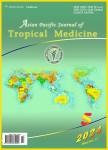Occurrence of Escherichia coli virulence genes in feces of wild birds from Central Italy
Occurrence of Escherichia coli virulence genes in feces of wild birds from Central Italy作者机构:Department of Veterinary ScienceUniversity of Pisa CRUMA-LIPU
出 版 物:《Asian Pacific Journal of Tropical Medicine》 (亚太热带医药杂志(英文版))
年 卷 期:2019年第12卷第3期
页 面:142-146页
核心收录:
学科分类:090601[农学-基础兽医学] 09[农学] 0906[农学-兽医学]
主 题:Wild birds Enteropathogenic Escherichia coli Enterohemorrhagic Escherichia coli Shiga-toxins producing Escherichia coli
摘 要:Objective: To investigate the potential role of wild birds as fecal spreaders of enteropathogenic,enterohemorrhagic and Shiga-toxins producing Escherichia coli(E. coli),enteropathogenic E. coli,enterohemorrhagic E. coli and Shiga toxin-producing E. coli strains. Methods: Fecal samples collected from 121 wild birds of different orders and species were submitted to molecular analyses. In particular,eaeA encoding intimin,hlyA encoding for hemolysin,stx1 and stx2 genes encoding Shiga-toxins 1 and 2,respectively,were investigated. Results: Overall,21(17.35%) fecal samples resulted positive for at least one of the investigated genes. In detail,12(9.91%) samples were positive for eaeA,10(8.26%) for stx1,4(3.31%) for hylA and 1(0.83%) for stx2. An owl(Athene noctua) positive for the four investigated genes suggesting that it harbored a STEC strain. However,virulence genes characterizing EPEC,and EHEC strains were mainly found among seagulls,waterfowl and feral pigeons. Conclusions: Seagulls,waterfowl and feral pigeons,which frequently reach and contaminate rural,urban and peri-urban areas with their droppings,may be important sources of E. coli infection for other animals and humans.



